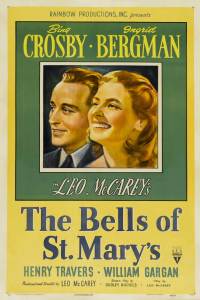 The Bells of St. Mary’s, Leo McCarey’s follow-up to his smash hit Going My Way (which won the Academy Award for best picture of 1944), premiered in New York City on December 6, 1945. It was one of the first really “respectable” sequels, and, like Going My Way, was nominated for Oscars in all the big categories; best picture, director, actor, and actress. (Billy Wilder’s The Lost Weekend ended up taking home the awards for best picture, director, and actor, and Joan Crawford won the best actress award for Mildred Pierce.)
The Bells of St. Mary’s, Leo McCarey’s follow-up to his smash hit Going My Way (which won the Academy Award for best picture of 1944), premiered in New York City on December 6, 1945. It was one of the first really “respectable” sequels, and, like Going My Way, was nominated for Oscars in all the big categories; best picture, director, actor, and actress. (Billy Wilder’s The Lost Weekend ended up taking home the awards for best picture, director, and actor, and Joan Crawford won the best actress award for Mildred Pierce.)
In The Bells of St. Mary’s, Bing Crosby reprises the role of Father O’Malley, for which he won an Academy Award for best actor of 1944, and he is joined by Ingrid Bergman, the best actress winner of 1944 (for Gaslight). The talent pool might be heavy, but the film itself is pretty light. There’s a disease, but it’s not fatal; there’s a bunch of needy kids running around, but the word “orphan” is never heard; and the sisters are in danger of losing St. Mary’s, but keep your fingers crossed for a Christmas miracle.
Like a lot of sequels, The Bells of St. Mary’s sticks with the formula of its predecessor. Father O’Malley is still the new guy in town, he’s still freewheeling and freethinking, and he butts heads with the other members of the clergy. His foil in Going My Way was Barry Fitzgerald as a crotchety old Irish priest, and in The Bells of St. Mary’s it’s the luminous Ingrid Bergman as Sister Benedict, a nun who was born in Sweden and raised in Minnesota. Bergman projects equal parts wisdom and naivete, and her performance is beatific enough, at least on the surface, to make up for what the role lacks in substance. The scene in which she masters the techniques of boxing by reading a book and then teaches the sweet science to a young boy who is being bullied is both funny and touching.
Crosby builds on his characterization of Father O’Malley. He’s a little older and wiser than he was in Going My Way, but not much else has changed. He’s still a “modern” thinker. He’s still a magnet for young girls in trouble, and if someone has a problem that can be solved with a song, he’s still happy to sit down at a piano and lend his golden pipes to the situation. Crosby will never be mistaken for Laurence Olivier, but he’s believable and charismatic in this picture. Enough so that he can deliver lines like, “If you’re ever in trouble, just dial ‘O’ … for O’Malley,” and not automatically trigger the viewer’s gag reflex.
The world of The Bells of St. Mary’s is much like our own, but the problems in it are solved with broad strokes and last-minute changes of heart instead of time and hard work. All it takes to mend a broken family is simply locating the wayward father, and getting a new parish is no harder than praying for it (and cajoling an old millionaire to donate his latest high-rise condominium).
Going My Way and The Bells of St. Mary’s are both holiday classics, even though neither focuses too much on Christmas. There’s a cute scene in The Bells of St. Mary’s in which some very small children stumble and improvise their way through a rehearsal of a Christmas pageant, but that’s about it. Oh, and a year later, astute viewers will be able to spot The Bells of St. Mary’s on the marquee of the local movie house in Bedford Falls when Jimmy Stewart runs through downtown wishing everyone and everything a Merry Christmas at the end of It’s a Wonderful Life.
Pingback: The Bamboo Blonde (July 15, 1946) « OCD Viewer
Pingback: The Miracle of the Bells (March 16, 1948) « OCD Viewer